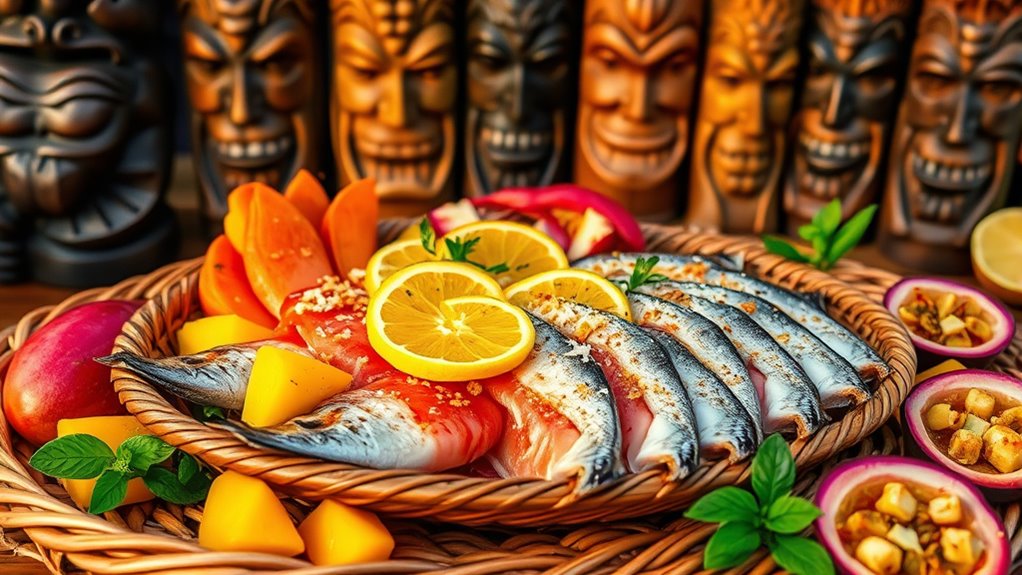Polynesian cuisine centers around natural ingredients like coconut milk, taro, sweet potatoes, fresh fish, and pork, cooked using traditional methods like earth ovens, steaming, and grilling. Iconic dishes like kalua pork and poi symbolize cultural pride and community bonds, especially during festivals and luaus. Unique flavors come from coconut, vanilla, and fermented delicacies such as fafaru. External influences add modern twists, but the focus remains on heritage and shared traditions—exploring these culinary stories reveals a rich cultural tapestry.
Key Takeaways
- Polynesian cuisine centers on natural ingredients like coconut milk, taro, sweet potatoes, fresh fish, and pork, cooked using earth ovens, steaming, and grilling.
- Traditional dishes such as kalua pork, poi, and poisson cru symbolize cultural identity and community bonds, especially during festivals and luaus.
- Coconut-based desserts like po’e, firi firi, and fermented delicacies like fafaru highlight Polynesia’s resourcefulness and communal traditions.
- External influences from European, Asian, and Western traders have enriched Polynesian cuisine, blending new ingredients and techniques with traditional methods.
- Culinary practices emphasize cultural heritage, with earth ovens and shared meals fostering social bonds, cultural pride, and the preservation of culinary traditions.
Traditional Ingredients and Cooking Techniques in Polynesian Cuisine
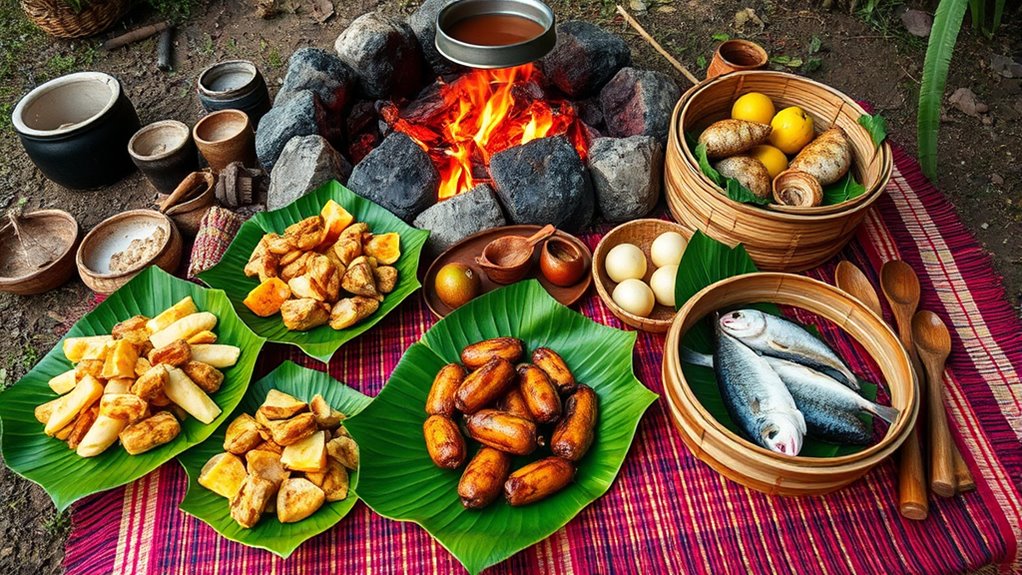
Polynesian cuisine relies heavily on a few key ingredients that define its distinctive flavors. Coconut milk stands out as a versatile element, enriching both savory and sweet dishes with its creamy texture and tropical aroma. Taro and sweet potatoes are staple root vegetables, often mashed or boiled to serve as side dishes or ingredients in stews. Fresh fish and pork are primary protein sources, frequently grilled or roasted. Traditional cooking techniques include earth ovens, like the Hawaiian umu or Tahitian ahima’a, which cook food slowly underground, preserving flavor and tenderness. Steaming and grilling are common methods, emphasizing natural flavors. Local produce such as bananas and vanilla are used to add sweetness and aroma. These ingredients and methods reflect Polynesia’s resourcefulness and deep connection to nature. Vetted – The Pinball Spot
Iconic Polynesian Dishes and Their Cultural Significance
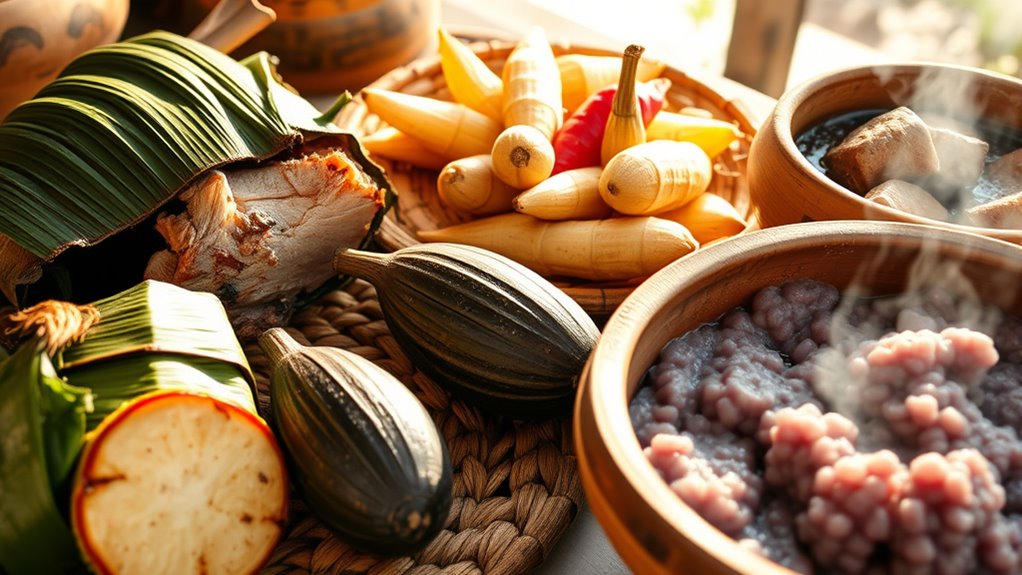
Many of the most iconic dishes in Polynesian cuisine are deeply rooted in cultural traditions and serve as symbols of community and identity. When you enjoy Kalua pork, you’re tasting a dish that connects you to Hawaiian ancestral practices of underground cooking, symbolizing communal gatherings. Poi represents more than sustenance; it embodies the importance of taro in Hawaiian culture and the shared effort in its preparation. In Tahiti, Poisson Cru au Lait de Coco highlights the island’s reliance on fresh fish and coconut milk, reflecting local abundance. Samoan dishes like Palusami showcase the use of coconut and taro, emphasizing family and tradition. These dishes aren’t just food—they’re expressions of history, social bonds, and cultural pride woven into every bite. Traditional cooking methods play a crucial role in preserving these culinary practices and maintaining cultural identity across Polynesian communities.
The Role of Earth Ovens in Polynesian Culinary Practices
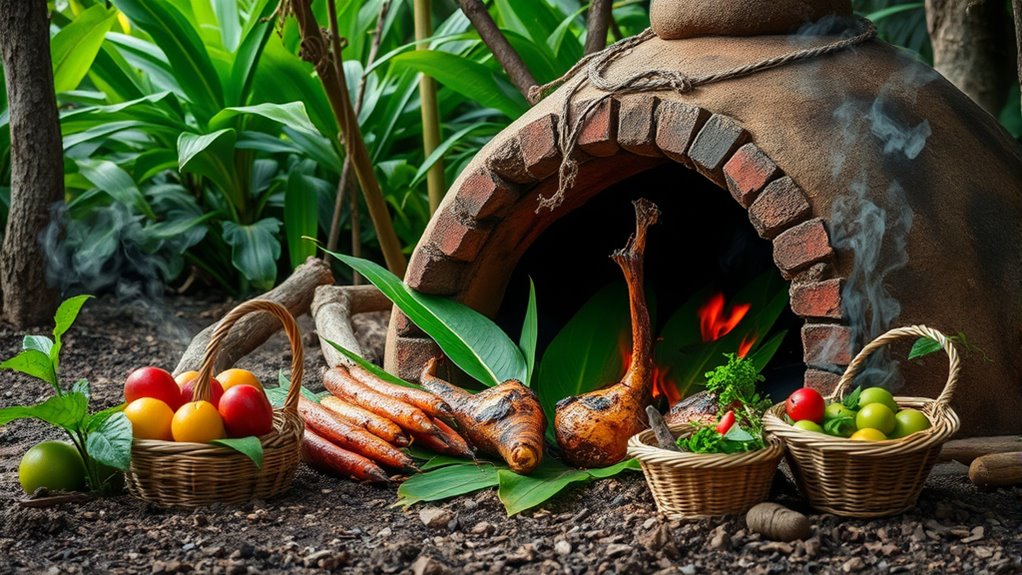
Earth ovens have long been a cornerstone of Polynesian cooking, shaping the flavors and traditions of the islands. You dig a pit, line it with hot stones, and layer banana leaves and food inside. The heat slowly cooks the ingredients, infusing them with smoky richness. Imagine this process:
| Step | Description |
|---|---|
| Prepare | Stones heated beneath fire |
| Layer | Food wrapped in leaves inside |
| Cover | Earth covers the pit |
| Cook | Slow cooking for hours |
This method allows you to cook large quantities of meat, fish, and vegetables evenly. Earth ovens are crucial in festivals and communal gatherings, preserving ancient techniques and creating dishes full of flavor and cultural meaning. These traditional cooking methods highlight cultural heritage and connect communities through shared culinary experiences.
Unique Flavors of Samoan Culinary Traditions
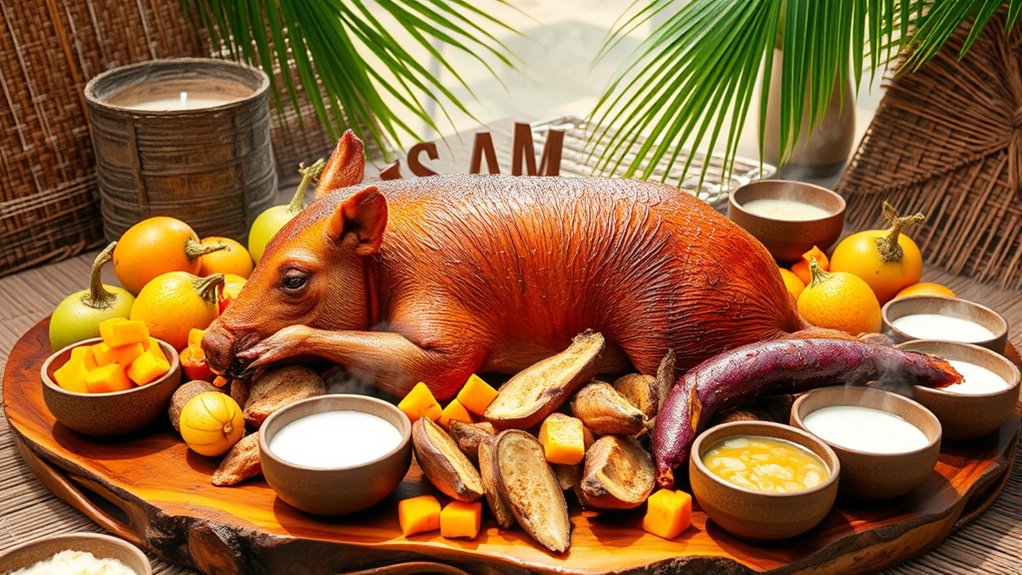
You’ll notice that coconut milk plays a crucial role in Samoan dishes, adding rich flavor and texture. Traditional cooking techniques like steaming and roasting enhance these flavors and bring out the natural qualities of local ingredients. By combining these methods with coconut milk, Samoan cuisine creates distinctive tastes that reflect its cultural heritage. Mastery of cooking techniques is essential for authentic preparation and flavor development.
Coconut Milk Enhancements
Samoan cuisine showcases how coconut milk can be transformed into a variety of distinctive flavors that elevate traditional dishes. You can infuse coconut milk with ingredients like vanilla, pandan leaves, or ginger to add depth and aroma. This versatile ingredient enhances savory dishes such as chicken or fish, giving them a rich, creamy texture, or sweet treats like Faikakai Malimali, where it’s used in coconut syrup. By experimenting with different flavorings, you reveal new tastes that highlight Samoa’s culinary creativity.
| Flavoring Ingredient | Resulting Dish Enhancement |
|---|---|
| Vanilla | Sweet coconut desserts and drinks |
| Pandan leaves | Fragrant rice and puddings |
| Ginger | Spicy depth in savory coconut dishes |
Traditional Cooking Techniques
Have you ever wondered how traditional Polynesian cooking creates such distinctive flavors? It all comes down to their unique techniques, especially earth oven cooking. You dig a pit, line it with hot stones, and place your food inside—covering it with leaves and earth to trap the heat. This method, called umu or ahima’a, slowly roasts meats like chicken and pork, infusing them with smoky, tender goodness. Steaming is also common, using banana leaves or woven baskets to cook vegetables and fish gently. Grilling over open flames brings out bold flavors in seafood and meats, while roasting in traditional ovens enhances sweetness and aroma. These methods, combined with traditional cooking techniques, give Polynesian dishes their rich, layered tastes that reflect centuries of culinary tradition.
Tahitian Desserts and Fermented Delicacies
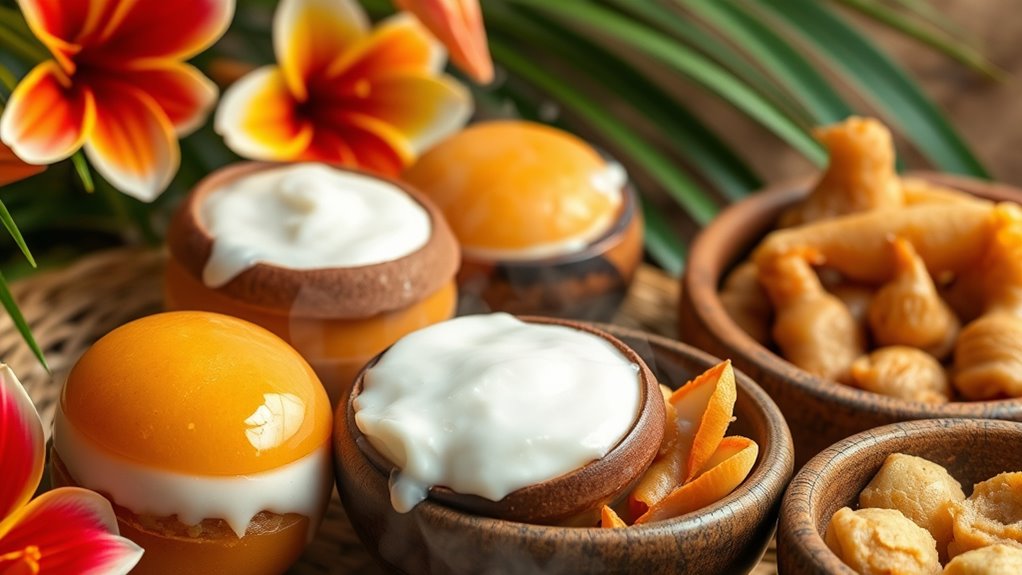
Tahitian desserts often feature rich coconut flavors and unique preparation methods that highlight local ingredients. Fermentation plays a key role in creating traditional delicacies like Fafaru, which offers a distinctive tangy taste. You’ll also find coconut-infused sweets that showcase the island’s love for blending sweet and savory flavors. Monitoring the cost-effective production of ingredients can help maintain authentic flavors while managing expenses.
Traditional Tahitian Desserts
Traditional Tahitian desserts highlight the island’s rich use of tropical fruits and coconut products, transforming simple ingredients into delightful treats. You might savor po’e, a sweet, dense pudding made from mashed bananas or breadfruit, baked in an ahima’a oven and topped with coconut cream. Another favorite is firi firi, soft doughnuts infused with coconut milk and sugar, often enjoyed during festivals or gatherings. Poisson cru, though primarily a savory dish, is sometimes served as a sweet marinated fish with coconut milk and lime, offering a unique flavor profile. Coconut-based desserts are common, utilizing shredded coconut or coconut cream to enhance sweetness and richness. These treats reflect Tahiti’s love for tropical flavors, emphasizing natural ingredients and communal enjoyment.
Fermentation Techniques in Fafaru
Fermentation plays a crucial role in preparing fafaru, a distinctive Tahitian delicacy, by transforming fresh tuna into a pungent, flavorful dish. You start by cleaning and salting the tuna, then burying it in a mixture of crushed breadfruit, salt, and sometimes grated taro. This mixture is left to ferment for several days, during which natural bacteria break down the fish proteins, creating a strong aroma and tangy taste. The fermentation process not only preserves the fish but also intensifies its flavor, making fafaru a cherished ingredient in Tahitian cuisine. You typically serve fafaru with coconut cream, taro, or breadfruit, allowing the fermentation’s pungency to complement the richness of the accompanying dishes. This method reflects Polynesian ingenuity in utilizing fermentation for preservation and flavor enhancement. Additionally, fermentation enhances the nutritional value of the ingredients, making the dish not only flavorful but also beneficial for health.
Coconut-Infused Sweets
Have you ever tasted the rich, creamy sweetness of coconut-infused desserts in Polynesian cuisine? If not, you’re missing out on a world of flavor. These treats highlight coconut’s versatility and cultural significance.
- In Tahiti, Po’e blends mashed bananas with coconut cream, baked in an ahima’a oven for a tender, sweet dessert.
- Samoa’s Faikakai Malimali features dumplings soaked in fragrant coconut syrup, offering a comforting, indulgent taste.
- Tahitian Firi Firi doughnuts, flavored with coconut milk and sugar, deliver crispy, sweet bites that celebrate coconut’s role in festive treats.
These desserts are more than just sweets—they’re a reflection of community, tradition, and the island’s abundant coconut resources. Incorporating natural ingredients like coconut in traditional recipes demonstrates the importance of authentic materials in Polynesian culinary practices. Indulge in these coconut-infused delights and experience Polynesia’s rich culinary heritage.
Popular Hawaiian Comfort Foods and Modern Favorites

Hawaiian comfort foods and modern favorites reflect the island’s rich culinary heritage while embracing contemporary tastes. You might enjoy dishes like loco moco, a hearty combination of rice, a hamburger patty, fried egg, and gravy that offers a satisfying, nostalgic flavor. Spam fried rice has become a beloved quick meal, blending savory Spam with rice and vegetables. Kalua pig, traditionally cooked in an underground oven, remains a festive favorite, especially during luaus. Shave ice, with flavored syrups over finely shaved ice, offers a invigorating treat on hot days. These foods connect you to Hawaii’s history while satisfying modern cravings. They highlight the island’s love for hearty, flavorful, and accessible dishes that bring people together.
Significance of Community Gatherings and Festivals in Polynesian Food Culture
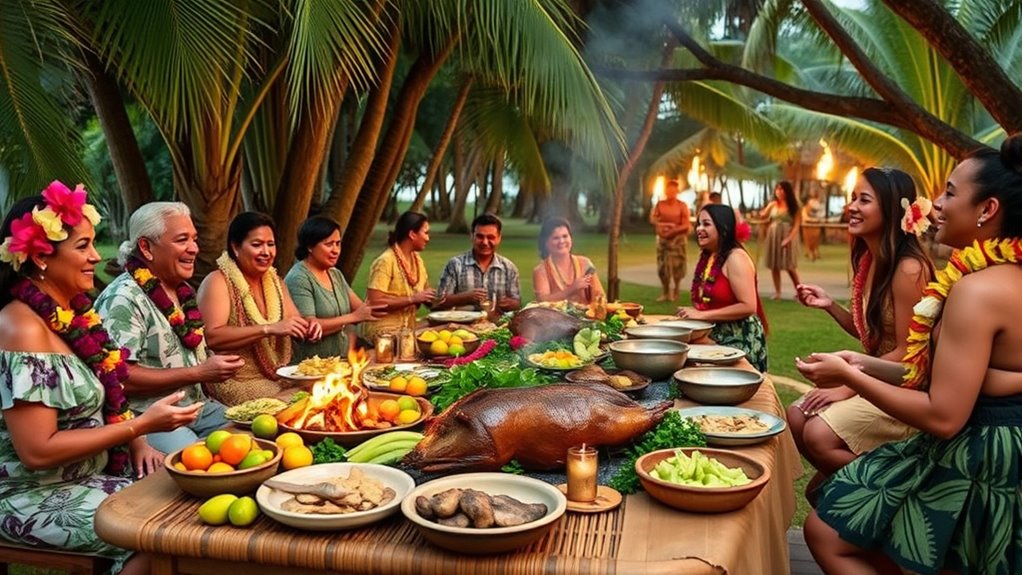
Community gatherings and festivals are at the heart of Polynesian food culture, transforming meals into shared experiences that strengthen bonds and celebrate heritage. During luaus and festivals, you join others in cooking with earth ovens, savoring traditional dishes like kalua pig or poi. These events create a sense of unity, allowing you to connect with your community and honor ancestors. The aroma of coconut milk-filled dishes and the sounds of laughter fill the air, evoking warmth and belonging.
Community festivals unite us through shared Polynesian dishes, laughter, and honoring traditions.
- You feel the joy of communal cooking, where everyone contributes and shares.
- You experience the pride of preserving traditions through food and celebration.
- You forge lasting bonds, creating memories rooted in shared culture and history.
Influence of External Cultures on Polynesian Culinary Heritage
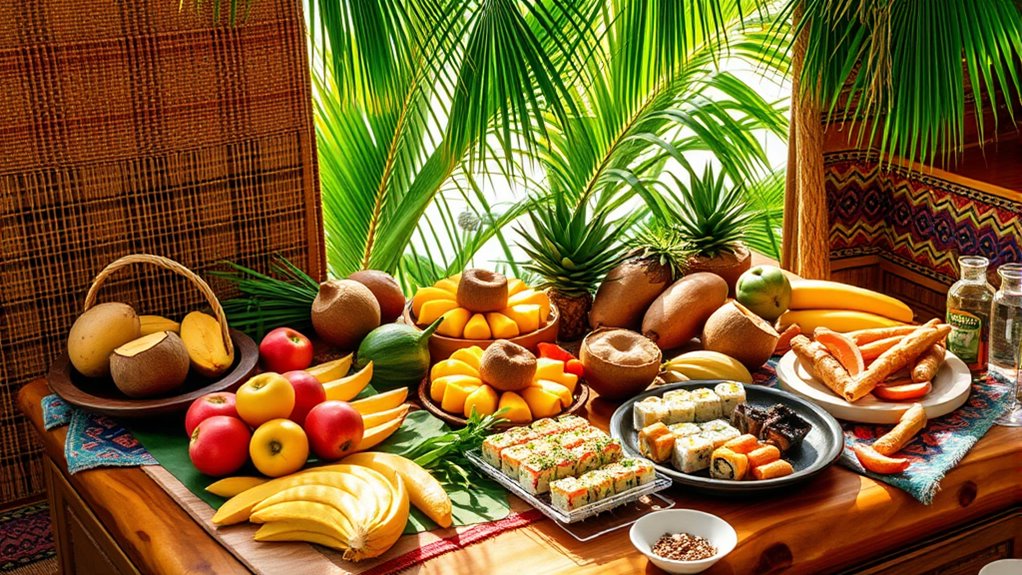
Polynesian culinary heritage has been shaped markedly by external influences brought through centuries of contact and trade. European explorers introduced new ingredients like breadfruit, sugarcane, and spices, which blended with local staples. Asian traders brought soy sauce, noodles, and tropical fruits, enriching traditional dishes. During the 19th and 20th centuries, Western colonization introduced canned goods, processed foods, and new cooking techniques, such as frying and baking. These influences are evident in dishes like Hawaiian Spam fried rice and Tahitian doughnuts, Firi Firi. Additionally, global trade has popularized ingredients like vanilla and coffee, now integral to Polynesian flavors. While maintaining core traditions, Polynesian cuisine continuously adapts, embracing external elements that enhance and diversify their culinary heritage. The integration of modern technology has also facilitated the preservation and dissemination of traditional recipes, ensuring that Polynesian culinary practices remain vibrant and relevant in a changing world.
Frequently Asked Questions
How Do Polynesian Cooking Methods Vary Across Different Islands?
You’ll notice that Polynesian cooking methods differ across islands mainly due to local resources and traditions. For example, Hawaiians often use earth ovens called umu for slow roasting, while Tahitians prefer ahima’a, a stone oven for baking. Samoans cook with coconut milk and steam foods, and in many places, grilling and steaming are common. These variations reflect each island’s unique environment and cultural influences, creating diverse culinary experiences.
What Are Traditional Polynesian Beverages Besides Coconut-Based Drinks?
Did you know that traditional Polynesian beverages often include fermented drinks? Besides coconut-based drinks, you can enjoy kava, a calming root beverage popular in Polynesian cultures. You might also taste ‘ava, a traditional ceremonial drink made from kava, which plays a significant role in social rituals. These beverages highlight the cultural importance of communal sharing and natural ingredients in Polynesian life.
How Has Modern Cuisine Influenced Traditional Polynesian Recipes?
Modern cuisine has considerably influenced traditional Polynesian recipes by blending local ingredients with international flavors. You might find dishes like Spam fried rice or Hawaiian meatballs, which incorporate processed foods and Western culinary techniques. Chefs also experiment with fusion styles, adding new spices or cooking methods to classic dishes. This evolution keeps Polynesian cuisine vibrant, appealing, and relevant, while still honoring its cultural roots through shared ingredients and communal eating traditions.
Are There Specific Etiquette Practices During Polynesian Communal Meals?
During Polynesian communal meals, you should show respect by waiting for the host to start, using your hands to eat where appropriate, and sharing food openly. It’s customary to express gratitude for the meal and to participate actively in conversations. You might also observe local customs, such as offering a prayer or blessing before eating, and avoiding wastefulness, as sharing and community are central to Polynesian dining etiquette.
How Do Festivals Enhance the Preservation of Polynesian Culinary Traditions?
Festivals play a crucial role in preserving Polynesian culinary traditions by showcasing traditional dishes and cooking methods like earth ovens and communal feasts. You get to participate in authentic food practices, ensuring they’re passed down through generations. These celebrations also strengthen cultural identity, encourage sharing recipes, and keep culinary customs alive. By attending, you’re helping sustain the unique flavors and techniques that define Polynesian cuisine, making sure they thrive for future generations.
Conclusion
While some might think Polynesian cuisine is simple, its rich flavors and cultural significance tell a different story. By exploring traditional ingredients, cooking methods, and festive gatherings, you see how deeply food connects communities. Even if you prefer modern dishes, embracing these culinary traditions offers a deeper appreciation for Polynesia’s vibrant heritage. So, don’t overlook these flavors—experiencing them enriches your understanding of a culture that values food as a shared, meaningful tradition.

